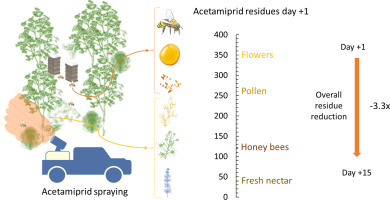Giving Beekeeping Guidance by cOmputatiOnal-assisted Decision making
An insight into the risk of acetamiprid exposure in honey bee colonies
Over the last few decades, honey bee colonies have shown abnormal mortality rates. Landscape changes due to human pressure and pesticide use in modern agriculture and even forestry are some of the leading causes of colony losses. In a new study ("Exposure and risk assessment of acetamiprid in honey bee colonies under a real exposure scenario in Eucalyptus sp. landscapes") published in the Science of The Total Environment journal, B-GOOD partners from University of Coimbra & Wageningen Food Safety Research collaborated to examine the effects of acetamiprid exposure on honey bee colonies.

To evaluate the risks of exposure under field conditions, as well as to test the use of in-situ tools for monitoring, the scientists analysed samples for the presence of acetamiprid residues. The flowers, fresh nectar, honey bees, and colony products samples were collected from the two honey bee colonies, installed in five Eucalyptus sp. plantations where Epik® (active substance: acetamiprid) was applied as in a common spraying event to control the eucalyptus weevil pest.
Through the use of Lateral Flow Devices (LFDs), which turned out to be a cheap and easy tool to apply in the field, the researchers found that spraying up to 22 % of honey bees' foraging area does not harm the colonies, according to the calculated Exposure to Toxicity Ratio (ETR) values. Other important findings include that landscape heterogeneity in forested areas compromises pesticide exposure assessment, the increase of the sprayed area leads to higher acetamiprid residues in the colonies, and honey bee colony products can be used as a bioindicator of environmental pollution.
To conclude, acetamiprid exposure does not harm honey bee colonies when applied at the recommended dose.
Read the full paper here.